Win CENS ProFlex DX5 earplugs worth £1,149 – enter here
Choke options for shotguns – just what are they?
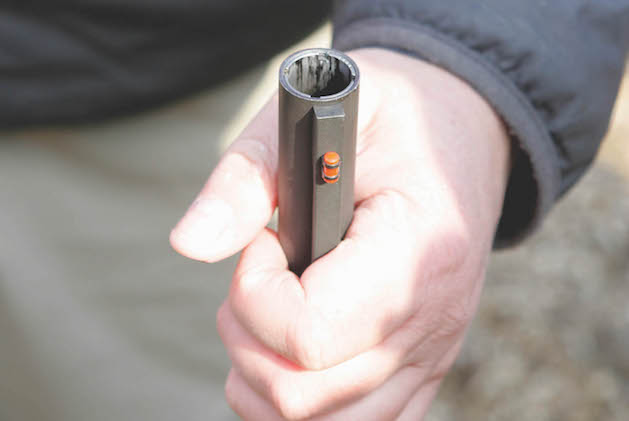 A semi automatic shotgun fitted with a multi choke
A semi automatic shotgun fitted with a multi choke
The issue of shotgun chokes and which combinations are winners raises its head regularly in the shooting world. For some, it is a subject worthy of hours of deliberation and debate. For others, it is far less concerning. As a youth I recall a farmer who had a Mossberg pump-action shotgun with a twist choke. Turning it anticlockwise opened the choke. If the farmer thought there was the chance of a fox, he simply gave it a few twists to the right to tighten it. He would not have a clue what level of choke he was using but these shotgun choke options worked for him .
Chokes do require a bit more thought for certain applications as they are an integral part of shooting, but be aware that there is not a definitive answer. All shooters and guns are different and, depending on the disciplines or quarry you shoot, may require different solutions.
Shotgun choke options
For the benefit of anybody reading this who is new to shooting, or comes from a background in rifle shooting, chokes are essentially a thickening, or constriction, of the nominal bore dimension of a shotgun barrel a given distance from the muzzles. This can be a means of controlling the spread of shot a given distance from the muzzles. True cylinder in a 12-bore, that is without constriction, is 0.729 of an inch. Every increment of choke thereafter is measured in increments of a ten-thousandth of an inch. Fixed-choked shotguns can be threaded to take multichokes but require a reasonable amount of wall thickness in the first place for this conversion to be carried out. It is vital that the multichokes fit tightly, as due to the thread being cut the wall thickness is reduced and should gas from the cartridge get between the choke and the barrel wall it can, potentially, cause bulging. Work such as this should be carried out by a specialist.
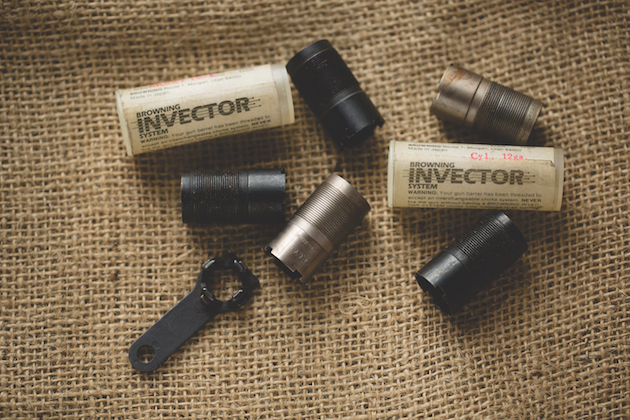
Test a variety of choke and cartridge combinations to see what works best
Retro fitting
Graham Brown: “Multichokes, and retro choke fitting, largely began to emerge in the 1970s and ’80s and offered the shooter much more choice. The days of visiting a Sporting layout carrying a tightly bored Trap gun and an open-choked Skeet gun were over if you wanted them to be.
“The ‘Sporter’ was born, a gun that was perhaps a hybrid of the previous two. A bit longer in the barrel than the Skeet gun, a bit lighter than the Trap gun, but fitted with multichokes it could potentially attain the best of both worlds. Why lug two guns around, puffing and panting, when you could breeze around a layout with just one?”
Some guns, such as the Browning B125, fitted with the Browning Invector multichoke system, had slightly flared barrels to accommodate the multichokes. This ceased after a while and it was difficult at a glance to tell if the sleeker gun was fitted with multichokes. One potential issue of adding removable chokes to a gun is that it may affect its balance. Converting a fixed-choke gun to a multichoke should not affect balance, if done properly, as the amount of metal removed to accommodate the screw threads can be equal to the weight of the multichoke.
Factors affecting the pattern of shot can be down to the length of the choke. The more progressive the constriction is, the better a pattern should be obtained. Short chokes where the constriction is more abrupt may affect patterning. However, there is a small fly in the ointment. Hardness of shot and wad design can alter between cartridges and therefore a half choke, for example, may throw tighter or wider patterns depending on the above. Your choke won’t necessarily do what it says on the tin.
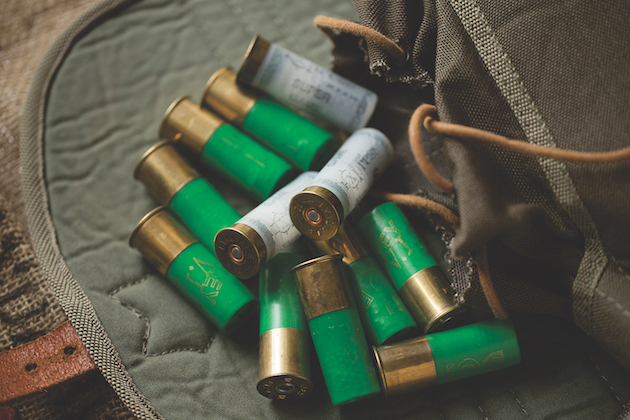
Different ammunition with a range of wad designs and loads can change results
Antimony is used as a hardener in lead. An antimony content of 8% could be considered hard shot; 5% would be for softer shot. So, what does this do and why the difference? When hard shot goes through a tight choke it can result in more flyers, hence a wider pattern. The softer shot slips through without any ‘bouncing’ and may give a tighter pattern, though some pellets may become deformed and the flight of those pellets may be a bit irregular. As a rough rule of thumb, hard shot is good for smashing clays, and softer shot may give cleaner kills on game due to it deforming and dumping more energy. Cartridges deserve more attention than they sometimes get.
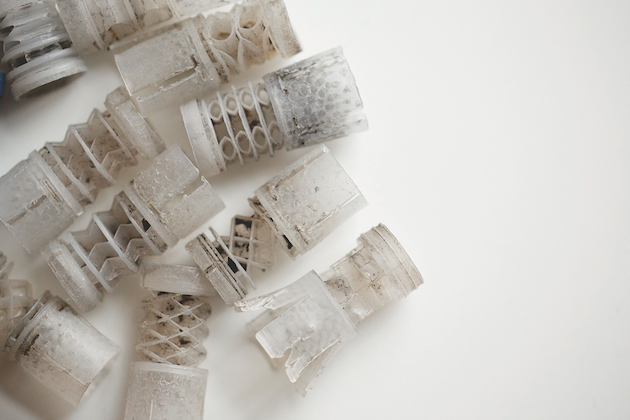
The design of plastic wads can vary and may affect results
Petals attached
On the subject of plastic wads, these too can alter patterns at given distances. Wads that have the ‘petals’ attached to one another are more likely to keep the shot together for longer, hence tighter patterns, whereas wads that have petals already unjoined open up faster and may give wider patterns. There are chokes available called wad strippers that cause the wad to fall away promptly. This is designed to improve patterning but it can also avoid issues of littering where plastic wads are concerned.
Graham Brown again: “Having a balanced gun with the right cartridges and shotgun choke combination is essential for good shooting. It makes sense for a Trap shooter to use a tight choke for their clays as the clay is edge on and at longer distances. Conversely, a Skeet shooter is shooting clays at much closer distances so open chokes make sense.
“However, I don’t believe that shooters should use open chokes as a cure for poor shooting. If you are struggling as a shooter, then simply putting open chokes in the gun and hoping you will hit the clay with a wider pattern of shot isn’t going to work. A good shooter should be able to hit a clay at any range with a tight choke.
“For consistency and balance where clays are concerned, I simply use fixed chokes that are both half choke. For game I use fixed chokes that are full and full. I won’t be shooting game at close range and I want to ensure clean kills on taller birds. If you don’t like the idea of multichokes, then you can have a spare set of barrels made for your gun with a different combination of chokes in them. Patterning guns can be useful but shouldn’t be treated as the be all and end all. What appears on a pattern plate is not necessarily what is happening when the shot is in the air. Shot patterns are three dimensional and may have holes in them.
“The best way to see if you have good cartridge and shotgun choke combinations is to see how well you are breaking clays. Shoot some ‘belly on’ clays and if you are smashing them consistently then you are not only shooting well but have a gun that is throwing a good pattern. If you repeatedly get only a chunk of clay coming off, or a clay simply splitting in half, it has not been hit by many pellets and you may have to address your cartridge choice – or your shooting skills.
“I think some people fret too much about chokes. It can be a fascinating subject but can also confuse people and they worry about it too much. My belief is that it is the centre of the pattern and where you put it that matters the most.”
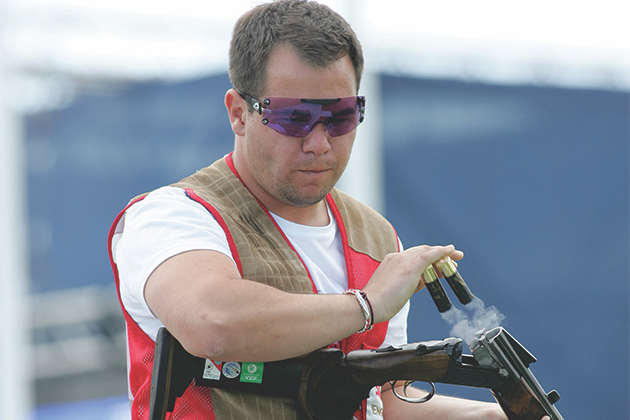
Top Shots like Steve Scott will be confident in their choke/cartridge choice
Urge to change
Graham acknowledges that fretting is normal behaviour in humans but it needs controlling. He cites the example of photographers at sporting events who have the urge to switch to a ‘better’ lens at the last moment. He admits that he is ‘guilty’ of such urges and he can see it in other shooters on the clay layout.
He says: “Shortly before their turn to step up, the shooter does a last-minute mental U-turn and begins furiously unscrewing and swapping their chokes. They are known on the clay circuit as ‘choke twiddlers’. With fixed chokes there are no such dilemmas and therefore you have removed one psychological factor that may be upsetting your shooting, unlike your vacillating, twiddling companions. Just like a professional photographer, the shooter should have assessed the situation beforehand and known what tools to use.”
Graham explains that there are all manner of shotgun choke options available these days, and that the variety of choice can be confusing. His advice is to take advice; try out different cartridges until you are happy with your combinations.
Remember, heavy loads can give poor patterns, whereas light loads, where the depth of the shot load is equal to the width of the cartridge, can give good patterns. Big is not always best. Consider wad design and pellet hardness and buy ammunition designed for what you want it to do. If you have confidence in your gun, chokes and cartridges you will be much more relaxed when it is your turn to step up. However, the issue of steel shot rumbling in the background may be a factor in what you do with your current guns or any subsequent purchases. Watch this space.
Related Articles
Get the latest news delivered direct to your door
Subscribe to Shooting Times & Country
Discover the ultimate companion for field sports enthusiasts with Shooting Times & Country Magazine, the UK’s leading weekly publication that has been at the forefront of shooting culture since 1882. Subscribers gain access to expert tips, comprehensive gear reviews, seasonal advice and a vibrant community of like-minded shooters.
Save on shop price when you subscribe with weekly issues featuring in-depth articles on gundog training, exclusive member offers and access to the digital back issue library. A Shooting Times & Country subscription is more than a magazine, don’t just read about the countryside; immerse yourself in its most authoritative and engaging publication.







